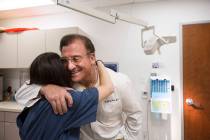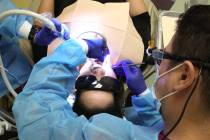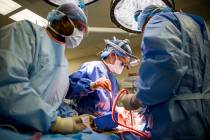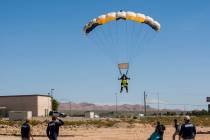Example for nation set here in Nevada
It can be done. It has been done. Right here in Nevada, where health care seldom receives accolades.
Deadly central line-associated bloodstream infections ---- part of the reason 99,000 Americans die each year from preventable hospital-acquired infections ---- have been cut dramatically. Yes, the central venous catheter, or central line, which doctors place in a patient's neck, chest, arm or groin to give fluids, blood or medications hasn't also carried dangerous bacteria anywhere near as frequently as in the past.
Over 18 months ending last summer, seven hospitals ---- Centennial, Summerlin, Southern Hills and North Vista in the Las Vegas Valley; Desert View in Pahrump; Nye Regional in Tonopah; and Northern Nevada in Sparks ---- reduced bloodstream infections to zero or nearly zero. Overall, 16 Nevada hospitals reduced those infections by 31 percent.
With medical centers in Nevada part of a four-year demonstration project undertaken by the Agency for Healthcare Research and Quality, the effort that included many hospitals in 44 states saw central line infections cut by 40 percent in intensive care units nationwide, saving an estimated 500 lives and more than $34 million in health care costs.
Consumer groups are rightly pushing the program as the national model for patient safety.
Ann Savin and David Woodard, safety experts for the Valley Health System, are understandably proud of a central line program that's seen Centennial Hospital experience zero infections over more than two years and Summerlin just one.
They point to the use of checklists by nurses and doctors and other practitioners before a procedure, much like pilots use before takeoff. The verbalized checklist is found in a customized insertion kit that includes sterile gowns and gloves, maximum barrier protection, the central line, disinfectant. Standardization, so insertion is always done one way, Savin said, is key.
Evidence-based medicine, Woodard noted, has shown that a new skin disinfectant, chlorhexidine, is best used on a patient. It's also better to change the patient dressing every seven days rather than every three to lessen the chance of disturbing the site. Nurses must check with doctors daily on the need for a central line. The longer it's in, the greater the chance for infection.
There has been much focus ---- rightfully so ---- on this approach empowering frontline caregivers, especially nurses who have historically not been included in safety programs, to make safety improvements.
Yet for the program to gain complete traction, the way all hospital executives deal with infections must change. In 2011, Dr. John Santa, director of the Consumer Reports Health Ratings Center, noted that in many hospitals "the standard of practice includes accepting that they (infections) occur, and that they kill people. Not preventing them is within the standard of practice."
Part of the problem, he said, is that some administrators find it difficult to persuade private practitioners, who bring paying patients to the hospital, to collaborate with other hospital employees in using evidence based protocols that increase safety.
Why the recent welcome emphasis by more hospitals on "zero infections," which consumers have pushed for decades? Does it have anything to do with the fact that in 2015, under the new health care law, hospitals with infection rates exceeding national averages begin to lose 1 percent of their Medicare funding?
That may not seem like much, but the federal government spent $563 billion in 2011 on 49 million Medicare recipients and the amount is expected to reach $970 billion by 2021.
In the final analysis, of course, it doesn't matter whether money or the desire to do the right thing ---- health care experts suggest it appears to be a combination of both ---- is the catalyst for finally wiping out infections. It must be done. Period.
What has been done in Nevada and elsewhere with central line infections proves that with the proper focus preventable hospital-acquired infections of all kinds ---- surgical site, catheter-associated urinary tract, ventilator-associated pneumonia, C difficle ---- can soon move to the only place they should be found: the history books.
Contact reporter Paul Harasim at pharasim@reviewjournal.com or 702-387-2908.

















